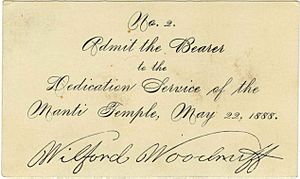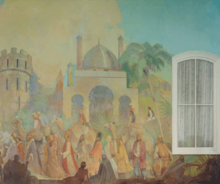Manti Utah Temple facts for kids
| Manti Utah Temple | |||||||||||||||||||||||||||||||||||||||||||||||
|---|---|---|---|---|---|---|---|---|---|---|---|---|---|---|---|---|---|---|---|---|---|---|---|---|---|---|---|---|---|---|---|---|---|---|---|---|---|---|---|---|---|---|---|---|---|---|---|
 |
|||||||||||||||||||||||||||||||||||||||||||||||
| Number | 3 | ||||||||||||||||||||||||||||||||||||||||||||||
| Dedicated | Quick facts for kids May 21, 1888 byLorenzo Snow |
||||||||||||||||||||||||||||||||||||||||||||||
| Site | 27 acres (10.9 hectares) | ||||||||||||||||||||||||||||||||||||||||||||||
| Floor area | 100,373 sq ft (9,325 m2) | ||||||||||||||||||||||||||||||||||||||||||||||
| Height | 179 ft (55 m) | ||||||||||||||||||||||||||||||||||||||||||||||
| Preceded by | Logan Utah Temple | ||||||||||||||||||||||||||||||||||||||||||||||
| Followed by | Salt Lake Temple | ||||||||||||||||||||||||||||||||||||||||||||||
| Official website: https://www.churchofjesuschrist.org/temples/details/manti-utah-temple • News & images | |||||||||||||||||||||||||||||||||||||||||||||||
|
|||||||||||||||||||||||||||||||||||||||||||||||
The Manti Utah Temple is the fifth temple built by The Church of Jesus Christ of Latter-day Saints. Located in the city of Manti, Utah, its construction was finished in 1888. It was one of the first temples built after the Mormon pioneers traveled west to Utah.
The temple was designed by architect William Harrison Folsom. It sits on a large hill overlooking the Sanpete Valley and can be seen from miles away. Like all temples of the church, only members who are in good standing are allowed to enter.
For a long time, the Manti Temple was one of only two temples in the world that used live actors for a special religious ceremony called the endowment. The other was the Salt Lake Temple. After renovations in 2024, the Manti Temple now uses a film for this ceremony, like other temples.
Contents
Building the Temple
Church president Brigham Young announced that a temple would be built in Manti on June 25, 1875. He dedicated the site for the temple on April 25, 1877. On that day, a story is told that Young pointed to a spot on the hill and said that the prophet Moroni from the Book of Mormon had stood there and dedicated the land for a temple.
At the time, the famous Salt Lake Temple was still being built. The church needed temples sooner, so the Manti, St. George, and Logan temples were built first. The site chosen for the Manti Temple was a stone quarry on a hill next to the town. The pioneers called the 27-acre (110,000 m2) area "Temple Hill."
The temple was finished in 1888. A private dedication was held on May 17, 1888. Three public dedications, led by Lorenzo Snow, were held from May 21 to May 23, 1888.
Art Inside the Temple
The temple is famous for its beautiful art, including large paintings called murals that cover entire walls. These were painted by several artists.
- C. C. A. Christensen painted the Creation Room mural between 1886 and 1887.
- Minerva Teichert painted the World Room mural in 1947.
- Robert L. Shepherd painted the Garden Room mural in 1946.
Some of the original murals were painted over because they were damaged. For example, an older Garden Room mural still exists behind the one painted by Shepherd. The temple is special because it still has a pioneer-era mural that has survived.
Minerva Teichert's Amazing Mural
Minerva Teichert was the first woman asked by the church to paint a temple mural. She was paid $4,000 for the project. While she worked, Teichert was sick from lead poisoning, which made her feel nauseous and caused her pain.
She set a goal to finish the huge project in just one month. She worked on tall scaffolding, sometimes as high as 28 feet. She and her assistant, Frank Stevens, were often scared of working so high up. Once, while painting a scene of the Tower of Babel, she fell but hurt her arm only slightly. She went back to work just a few hours later.
Her mural shows a "great pageant" of world history with 120 people in it. She proudly said she painted nearly 4,000 square feet (370 m2) in just 23 days. After some final touch-ups, the work took about 28 days in total.
Changes and Renovations
The Manti Temple has been updated several times over the years.
- In 1907, a large stone stairway was built leading up the hill to the temple doors.
- In 1935, the temple was lit up at night for the first time.
- In the 1940s, the grounds were improved, and rooms like the chapel and Garden Room were remodeled.
- In the 1960s, a tunnel that ran under the temple's east tower was closed. Cars and wagons used to pass through it. People used to joke that it was the only temple you could go through without a special pass, called a recommend.
A major renovation took place from 1981 to 1985. During this time, the murals and original furniture were restored. An elevator was added, and many rooms were updated.
Saving the Murals
In March 2021, the church announced plans to renovate the temple again. The plan included removing the historic murals to update the ceremony rooms. This news made many people sad because they loved the historic art.
A week later, the church said it would try to save the murals by carefully removing them. Then, on May 1, 2021, church president Russell M. Nelson made a new announcement. He said the murals would be preserved inside the temple. To provide more opportunities for members in the area, he also announced that a new temple would be built in the nearby city of Ephraim, Utah.
Architectural Style
The Manti Temple is a mix of several architectural styles, including Gothic Revival and French Renaissance Revival. The outside of the temple is made of a beautiful, cream-colored stone that came from the same hill where the temple stands.
The temple has two tall towers that are 179 feet (55 m) high. Inside these towers are amazing spiral staircases that show the skill of the pioneer builders. The temple has 100,373 square feet (9,325 m2) of floor space, with eight sealing rooms and four ordinance rooms for ceremonies.
Gallery
See also
 In Spanish: Templo de Manti para niños
In Spanish: Templo de Manti para niños
- The Church of Jesus Christ of Latter-day Saints in Utah
- Comparison of temples of The Church of Jesus Christ of Latter-day Saints
- List of temples of The Church of Jesus Christ of Latter-day Saints
- List of temples of The Church of Jesus Christ of Latter-day Saints by geographic region
- Mormon Miracle Pageant
- Temple architecture (Latter-day Saints)








